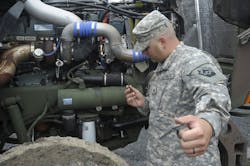Owner-operators might think oil analysis programs are just for fleets comprised of many multiples of trucks. But that’s where Scott Killips, CEO of Hubb Filters, will tell you that you’re wrong, for anyone owning and operating even just one truck can benefit from a consistent oil analysis program.
By way of background, prior to joining Hubb, Killips founded Accenture Technology Ventures where he helped foster the growth of several consumer good companies. He’s also been a partner with global consulting firm Booz Allen and worked in new product development at Gillette.
Here’s his advice to American Trucker readers on the value of oil analysis for fleets large and small.
Oil changes are one of the most important, ongoing, and expensive preventive maintenance items on a truck owner’s checklist. So it’s no wonder that extending the oil change interval is a popular topic, for finding the oil change interval and oil filter for your vehicle can reduce oil change costs by as much as 50%. But how do you find that right combination of oil change interval and oil filter without putting your truck at risk? Here’s a proven approach:
Step 1. Segmentation of your fleet: This requires some care. If you operate one truck, it’s simple, but if you operate two or more, you need to think about their operating environment, usage patterns, mileage, type of engine oil and oil filters. This segmentation is also a process; don’t expect to get it perfect.
Use this segmentation process to develop some ideas about what types of oil and oil filter combinations should be considered and speak to both current and potential oil and oil filter partners as part of this process.
Step 2. Build your current oil change cost model: This is a bit tedious but necessary. The reason for doing this is to understand your current costs for each segment and to establish a cost baseline. To calculate the current costs in a segment you must determine:
- Vehicle oil sump capacity
- Cost of oil per quart
- Labor rate per hour
- Oil change time in minutes
- Oil filter and disposal cost
- Number of vehicles involved, segmented by vehicle type
- Current oil change interval
- Annual mileage per vehicle
- Downtime costs for vehicles waiting for oil changes instead of being out on the road and on the job.
For example, a typical class 5-6 work truck spends about $37.50 on oil ($2.50 multiplied by 15 quarts), approximately $10 on a filter, and about $80 in labor assuming a one hour oil change, that's $107.50 per oil change and $430.00 per year based upon four oil changes.
Multiply that for a fleet of 100 trucks and you are looking at $43,000 annually; 1,000 trucks will cost $430,000.
It's possible to cut this oil change cost in half or more if you pair the right oil with the right oil filter with the right truck. We’ve consistently been able to double the oil drain interval for work trucks, even those that operate in challenging environments accompanied by high idle time, but we only recommend doing so with the guidance provided by oil analysis. Because once you’ve conducted oil analysis, you need to ask this question: What is it worth to extend the oil change interval by 50% or 100% or 200%? You might find that the savings are dramatic … or not worth the effort.
Step 3. Understand the latest oil formulations and oil filter technologies: A common problem we see is fleets evaluating different oils but not different oil filters. Far too often we see that the oil filter is holding back the performance of the oil and the ability of the fleet manager to extend the life of the oil. The oil and oil filter combination is critical to optimizing oil drain interval.
Recent developments in reusable, cleanable oil filter technology now make it possible to safely extend the useful life of your oil by keeping it cleaner for a longer time. Such filters allow you to pair a filter with oil that, together, enables you to extend a vehicle’s oil change interval without any risk to your fleet.
Plus, the right filter can increase the protection of certain vehicles, particularly those that spend a lot of time idling.
Yet, just as with the particular oil type you choose to use, you will find that not all vehicles are appropriate for a reusable filter.
Step 4. Use oil analysis as a guide: Oil analysis is critical to reducing the implementation risk because it provides you objective data that helps you make the right decisions for your different fleet segment combinations.
If you don’t have your own oil analysis machine, use a sampling technique to develop an oil analysis plan for your fleet.
That’s because it is not necessary to conduct an oil analysis each time you perform an oil change on a vehicle; that’s where the sampling technique comes into play.
Oil analysis machines enable you to develop vehicle specific rather than segment specific oil drain protocols. And, they enable you to make real time decisions on vehicle maintenance issues while a vehicle is being serviced. Oil analysis machines don’t come cheap, but these advantages can make sense for larger fleets.
Step 5. Implement your plan: Don’t forget to develop and implement a segment-specific oil, oil filter and oil change protocol based upon the results you gain from oil analysis – and then put that plan into action. And don’t forget to refine the plan based upon changes to your fleet, or new oil and oil filter technologies.
In summary, there are four elements to successfully optimizing oil change intervals for your fleet.
- The vehicle: Its age, use, and environment.
- The oil.
- The oil filter.
- Oil analysis.
Follow these proven steps and you will develop a segment specific plan that will reduce your oil change costs with less risk.


